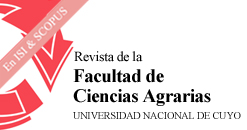Artículo de revista
Efecto del tratamiento térmico sobre la presencia de virus en bulbos de ajo (Allium sativum L.)
Effect of thermic treatment on the presence of virus in garlic (Allium sativum L.) bulbs
Velásquez-Valle, Rodolfo
-  Enviar un email al autor
Enviar un email al autor
Reveles-Hernández, Manuel
-  Enviar un email al autor
Enviar un email al autor
Chew- Medinaveitia, Yasmín Ileana
-  Enviar un email al autor
Enviar un email al autor
Reveles-Torres, Luis Roberto
-  Enviar un email al autor
Enviar un email al autor
Publicado en el 2017 en
Revista de la Facultad de Ciencias Agrarias,
Vol. 49, no. 1
Idioma:
Español
Resumen:
Español
Se evaluó la presencia de virus en bulbos de 24 variedades de ajo antes y después de
ser termo tratadas usando la técnica serológica DAS-ELISA para los virus TEV, SLV, GarCLV,
OYDV y LYSV. Los bulbos de ajo fueron expuestos a temperatura de 33 ± 1°C durante
un período de seis semanas. Después del tratamiento térmico, 23 variedades tenían al
menos un virus, sin embargo, ninguno de los cinco virus fue detectado en los bulbillos de
la variedad Español, también, la variedad ChJO 13 fue positiva solamente a TEV. TEV fue
el virus más persistente a través del tratamiento térmico. Independientemente del virus
o variedad, el porcentaje de bulbillos positivos virus fue de 53,5 y 45,1% antes y después
del tratamiento térmico respectivamente. La mayoría de los bulbillos mostró infecciones
múltiples en diversas combinaciones. Solamente TEV y SLV aparecieron en infecciones
simples o con un solo agente viral; después del tratamiento térmico solo el TEV conservó
esta característica. La concentración viral de TEV no mostró cambios significativos antes
y después del tratamiento térmico.
Inglés
It was evaluated the virus presence in cloves of 24 varieties of garlic before and after
being thermo-treated using the serological technique DAS-ELISA for TEV, SLV, GarCLV,
OYDV, and LYSV. Garlic bulbs were exposed to 33 ± 1 °C during a period of six weeks. After
thermic treatment, 23 varieties had one virus at least; however, none of the five viruses was
detected in the cloves of the variety Español, also, the variety ChJO 13 was only positive to
TEV. TEV was the more persistent virus through the thermic treatment. In spite of virus
or variety, the percentage of virus-positive cloves was 53.5 and 45.1% before and after
thermic treatment respectively. Most of the cloves showed multiple infections in diverse
combinations. Only TEV and SLV appeared as single infections or with only one virus; after
thermic treatment only TEV kept this characteristic. Viral concentration for TEV did not
show significant changes before and after thermic treatment.
Disciplinas:
Palabras clave:
Descriptores:
Velásquez-Valle, Rodolfo; Reveles-Hernández, Manuel; Chew- Medinaveitia, Yasmín Ileana; Reveles-Torres, Luis Roberto (2017) "Efecto del tratamiento térmico sobre la presencia de virus en bulbos de ajo (Allium sativum L.): ". En: Revista de la Facultad de Ciencias Agrarias, Vol. 49, no. 1, p. 157-165.
Dirección URL del artículo: https://bdigital.uncu.edu.ar/9343.
Fecha de consulta del artículo: 18/05/24.

Este obra está bajo una Licencia Creative Commons Atribución-NoComercial-CompartirIgual 3.0 Unported.
Conozca más sobre esta licencia >



